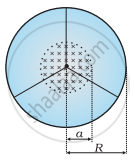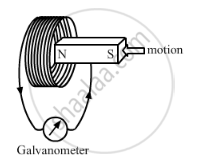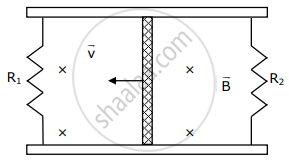Advertisements
Advertisements
प्रश्न
When an electric current is passed through any wire, a magnetic field is produced around it. Then why an electric iron connecting cable does not attract nearby iron objects when electric current switched on through it?
उत्तर
When an electric current is passed through a wire, it is true that a magnetic field is produced around it. However, such magnetic fields are very weak.
The magnetic field produced by an electric iron connecting cable is very weak and is not enough to attract nearby objects. Moreover, metallic wires of cables are shielded with a cover that prevents magnetic field to show its effect outside the cable.
APPEARS IN
संबंधित प्रश्न
A line charge λ per unit length is lodged uniformly onto the rim of a wheel of mass M and radius R. The wheel has light non-conducting spokes and is free to rotate without friction about its axis (Figure). A uniform magnetic field extends over a circular region within the rim. It is given by,
B = − B0 k (r ≤ a; a < R)
= 0 (otherwise)
What is the angular velocity of the wheel after the field is suddenly switched off?

Name one device which works on the phenomenon of electromagnetic induction.
When the magnet shown in the diagram below is moving towards the coil, the galvanometer gives a reading to the right.

() What is the name of the effect being produced by the moving magnet?
(2) State what happens to the reading shown on the galvanometer when the magnet is moving away from the coil.
(3) The original experiment is repeated. This time the magnet is moved towards the coil at a great speed. State two changes you would notice in the reading on the galvanometer.
A conducting square loop having edges of length 2.0 cm is rotated through 180° about a diagonal in 0.20 s. A magnetic field B exists in the region which is perpendicular to the loop in its initial position. If the average induced emf during the rotation is 20 mV, find the magnitude of the magnetic field.
What is an electromagnet? List any two uses.
Draw a labelled diagram to show how an electromagnet is made.
Give an illustration of determining direction of induced current by using Lenz’s law.
An alternating emf of 0.2 V is applied across an L-C-R series circuit having R = 4Q, C = 80µF, and L = 200 mH. At resonance the voltage drop across the inductor is
A conducting bar of length L is free to slide on two parallel conducting rails as shown in the figure

Two resistors R1 and R2 are connected across the ends of the rails. There is a uniform magnetic field `vec"B"` pointing into the page. An external agent pulls the bar to the left at a constant speed v. The correct statement about the directions of induced currents I1 and I2 flowing through R1 and R2 respectively is:
